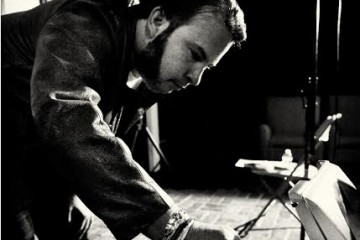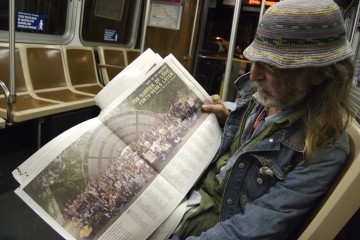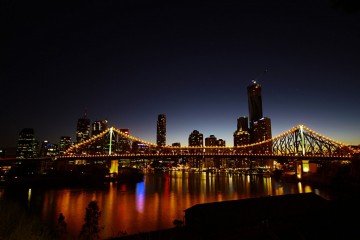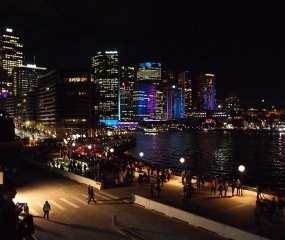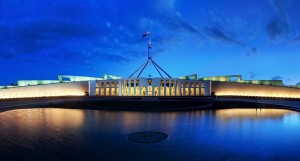When No News is Bad News: Remembering the SF Bay Guardian
January 28, 2012 — The night protesters clashed with police in downtown Oakland, the college kids on my train home from San Francisco were counting on their fingers how many of their friends had been arrested.
At the time it went over my head. Then Monday morning I turned up to work at The San Francisco Bay Guardian office and the news editor, Steven T Jones, came running.
“Yael’s been arrested,” he said before he and managing editor Tim Redmond, set about finding their missing reporter.
Back then, Yael Chanoff had basically been embedded with Occupy, so when MoveIn Day rolled around and OccupyOakland marched on a vacant building that had sat empty for six years, she was there when the Oakland Police Department tried to end a long day of confrontations by kettling protesters.
An Occupy Oakland Protest
This failed when a chain-link fence collapsed, allowing the protest march to continue. Still, 409 people found themselves in handcuffs that night, along with seven reporters.
Chanoff was one of them.
As Monday morning went on and news of the skirmish made international headlines, Redmond was busy combing the local jails.
No one knew where Chanoff was until around 11am when she turned up with a smile, wondering what the problem was. After spending 20 hours in a crowded, white room with a concrete bench, she knew she was about to write some great copy.
That was the San Francisco Bay Guardian at its finest. A faint glimmer of the paper’s past glory in otherwise hard times for the radical alternative-weekly.
Dude on Muni reading the Guardian. Is that Diamond Dave?
If a newspaper’s duty is to print the news and raise hell, than The Guardian did just that for most of its 48 year publishing history.
Defiant and sometimes downright weird, The Guardian was a paper of values that believed in a San Francisco for the poor, the workers, the artists, the LGBT, the immigrants, the homeless and pretty much anyone who found themselves on bottom in a land that only saluted winners.
On its game, The Guardian was fearless and rabidly independent. It was never the best paper, but its reporters carried the standard for Bay Area progressives and its very existence proved that what made San Francisco so special, to so many people, wasn’t yet dead in a city struggling with rising rents and a cultural shift.
So no matter how much red ink the alternative-weekly bled, no matter how tough times were, there was this feeling The Guardian wasn’t going anywhere. A San Francisco without the San Francisco Bay Guardian was impossible. The paper would never close.
Then they closed it.
On the morning of October 14, 2014, the owners waited until the profitable “Best of the Bay” issue had gone to print before putting up a notice on the website that the paper was dead. Then they told their former employees to clean out their desks. And that was it. End of story.
Not that people hadn’t seen it coming. About a year and a half ago, former publisher Bruce Brugman sold the paper to the San Francisco Newspaper Company, which had been buying up print media titles across the city for some time.
Only a few months earlier, the company had taken over The Guardian’s main rival, The SF Weekly. Back then, everyone knew one would eventually go, but no one knew which.
With hindsight, it’s clear The Guardian was always on the chopping block. Why would the San Francisco Newspaper Company maintain two mastheads competing for the same advertising revenue? And of the two, The Guardian’s reporters were far more likely to print, do or say something management didn’t like.
Troublemakers are bad for business but The Guardian had been in the business of making trouble since ’66.
June 2012 marked the end of an era in that way. That was the month the paper changed hands and the warehouse office went up for sale, eventually selling for (US) $6.5 million to an Irish design firm.
I remember the place well. Whether it was the cost of rent or the FBI kicking in the door, Brugman had reportedly bought the building so his paper always had somewhere to print the news with righteous fury.
That was a long time ago, though. By the time I got there, the place was dimly lit and the cubicles were more likely to be filled with office supplies and old computer parts than reporters. It was also pretty clear the place had come to rely heavily on intern labour.
“This is no copy and coffees gig,” the initial intern pitch went. “Intern reporters do all the work of a real reporter.” Translated, what The Guardian wanted was for free labour in exchange for some measure of “experience”, supplemented with a crash-course in investigative journalism.
But then, nothing about that is unusual in the US media industry and the deal sounded great to any fresh-faced university journalism student in desperate need of industry experience and a few publishing credits.
It sounded so great that I parachuted in from half way across the world for the opportunity, with no idea of what I was getting into. And I would do so again. Without question.
On the first day, Redmond met me at the gate and gave me the tour. Reception. The archives. Sales. Upstairs to news. My cubicle. The culture desk run by Caitlin Donoghue. The aging server and the corpse-like IT guy who tended it.
Office hours were ten to six. Weekdays only.
So for two days a week I caught the BART to 16th and Mission and made the 40 minute walk east, to the bottom of Potrero Hill. There was a bus, but it never seemed to go where it was supposed to.
There I worked alongside Redmond, a tall, thin man with a pony tail and big glasses who had spent three decades at The Guardian’s helm.
Tim Redmond and friends
Over two months, I learned he was an old school, no-bullshit, leftie progressive who would occasionally drop details about what he had been doing during the Sixties. San Francisco was his turf and he’d been in the trenches so long that, in a city where everyone is an activist, he seemed to know the resume and character of just about every major player.
As far as newspaper people come, Redmond was a down in the dirt, muckraking reporter who valued good investigative work and held a very “stick it to the man” attitude to publishing.
“You know what they used to say about editors of college newspapers when I was in college?” He asked once.
“Either you were already expelled, or you were on probation.”
And then there was “Steve” Jones. Blond haired and plain dressed, Jones never really spoke except to give orders and make changes to copy, between knocking out posts on local politics for the website.
Steve Jones and Mark Bieschke. The Guardian’s last Editor in Chief and Publisher, respectively
But then, he didn’t really have to say anything. The Soviet propaganda posters on his office wall and the lunch recommendation he gave for Ganim’s burger shop around the corner spoke volumes.
Ganim’s sold cold beer and anything fried. The place was no frills, with basic tables and a TV that played sports constantly. On lunch breaks, I watched all kinds of strange characters move through the place. Mostly though, I just remember immigrants and working men with skin like leather.
Sometimes, I would see Jones there amongst them, eating alone and talking to no one.
By that time the Redmond-Jones partnership was reaching the end of its lifespan. After the paper was sold, management were reportedly working to bring it back into the green. The way they wanted to do this was so very American: take an axe to labour costs. The paper was operating on a skeleton crew as it was and Redmond refused. Management pushed harder so Redmond and Donoghue walked.
That was June 2013 and must have been a premonition of things to come, as now, in October 2014, The Guardian is dead and the city it has served so faithfully is changing faster than ever.
Between the forced evictions, the high-rise developments and the flood of software developers heading west to seek their fortune, there seems to be no more room left for the ordinary people who made the city great.
Some may call this progress. If so, it is a very different kind of progress than the one that defined San Francisco and made it great — the one The San Francisco Bay Guardian, and its reporters-for-the-cause, spent almost half a century fighting for.
Image credits: Glenn Halog via Flikr, Steve Rhodes via Flickr and Luke Thomas via TheFogCityJournal.





